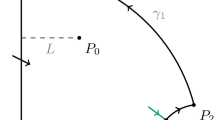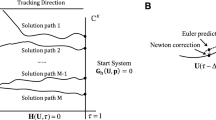Abstract
We study the linear instabilities and bifurcations in the Selkov model for glycolysis with diffusion. We show that this model has a zero wave-vector, finite frequency Hopf bifurcation, which is a forward or supercritical bifurcation, to a growing oscillatory but spatially homogeneous state and a saddle-node bifurcation, which is a backward or subcritical bifurcation, to a growing inhomogeneous state with a steady pattern characterised by a finite wavevector. We further demonstrate that by tuning the relative diffusivity of the two concentrations, it is possible to make both the instabilities to occur at the same point in the parameter space, leading to an unusual type of codimension-two bifurcation. We then show that in the vicinity of this codimension-two bifurcation, the initial conditions decide whether a spatially uniform oscillatory or a spatially periodic steady pattern emerges in the long time limit. It is also possible to form a co-existing patterned and time-periodic state by fine-tuning the diffusivity ratio for moderate values, in qualitative agreement with recent experimental studies.







Similar content being viewed by others
Availability of data and material
Not applicable.
References
Chandrasekhar, S.: Hydrodynamic and Hydromagnetic Stability. Dover Publications, New York (1981)
Platten, J.K., Legros, J.C.: Convection in Liquids. Springer, Heidelberg (1984)
Palm, E.: Nonlinear thermal convection. Annu. Rev. Fluid Mech. 7, 39 (1975)
Kuznetsov, Y. A.: Elements of applied bifurcation theory, Springer, Berlin
Strogatz, S.H.: Nonlinear dynamics. CRC Press, Florida (2000)
Bhattacharjee, J.K.: Convection and Chaos in Fluids. World Scientific, Singapore (1987)
Platten, J.K.: The soret effect: a review of recent experimental results. J. Appl. Mech. 73, 5 (2006)
Silber, M., Knobloch, E.: Pattern selection in steady binary-fluid convection. Phys. Rev. A 38, 1468 (1988)
Knobloch, E., Moore, D.R.: Minimal model of binary fluid convection. Phys. Rev. A 42, 4693 (1990)
Hollinger, St., Lücke, M.: Strongly nonlinear convection in binary fluids: minimal model using symmetry decomposed modes. Z. Phys. B 103, 531 (1997)
Fütterer, C.: Growth of nonlinear patterns in binary-fluid convection, analysis of models. Theor. Comput. Fluid Dyn. 16, 467 (2003)
Gallaire, F., Brun, P.-T.: Fluid dynamic instabilities: theory and application to pattern forming in complex media. Phil. Trans. R. Soc. A 375, 20160155 (2017)
Turing, A.M.: The chemical basis of morphogenesis. Philos. Trans. A Ser. B 237, 37 (1952)
Ricard, M.R., Mischler, S.: Turing Instabilities at Hopf Bifurcation. J. Nonlinear Sci. 19, 467 (2009)
Zhang, T., Xing, Y., Zang, H., Han, M.: Spatio-temporal dynamics of a reaction-diffusion system for a predator-prey model with hyperbolic mortality. Nonlinear Dyn. 78, 265 (2014)
Liu, B., Wu, R., Chen, L.: Turing-Hopf bifurcation analysis in a superdiffusive predator-prey model. Chaos 28, 113118 (2018)
Tyson, J., Kauffman, S.: Control of mitosis by a continuous biochemical oscillation: Synchronization
Tyson, J., Kauffman, S.: spatially inhomogeneous oscillations. J. Math. Biol. 1, 289 (1975)
Uecker, H., Wetzel, D.: Numerical Results for Snaking of Patterns over Patterns in Some 2D Selkov-Schnakenberg Reaction-Diffusion Systems. SIAM J. Appl. Dyn. Syst. 13, 94 (2014)
Ghergu, M., Radulescu, V.: A singular Gierer-Meinhardt system with different source terms. Proc. R. Soc. Edinburgh A 138, 1215 (2008)
Kepper, P.D., Castets, V., Dulos, E., Boissonade, J.: Turing-type chemical patterns in the chlorite-iodide-malonic acid reaction. Phys. D 49, 161 (1991)
Lengyel, I., Epstein, I.R.: A chemical approach to designing Turing patterns in reactiondiffusion system. Proc. Natl. Acad. Sci. (USA) 89, 3977 (1992)
Yi, F.Q., Wei, J.J., Shi, J.P.: Diffusion-driven instability and bifurcation in the Lengyel-Epstein system. Nonlinear Anal.: RWA 9, 1038 (2008)
Ghorai, S., Chakraborty, P., Poria, S., Bairagi, N.: Dispersal-induced pattern-forming instabilities in host-parasitoid metapopulations. Nonlinear Dyn. 100, 749 (2020)
Kumari, N., Mohan, N.: Positive solutions and pattern formation in a diffusive tritrophic system with Crowley-Martin functional response. Nonlinear Dyn. 100, 763 (2020)
Karaoglu, E., Merdan, H.: Hopf bifurcations of a ratio-dependent predator-prey model involving two discrete maturation time delays. Chaos Sol. Frac. 68, 159 (2014)
Li, C., Liu, H., Zhang, T., Yan, F.: Network mediated by small noncoding RNA with time delays and diffusion. Int. J. Bifurc. Chaos 27, 175 (2017)
Rovinsky, A., Menzinger, M.: Interaction of turing and Hopf bifurcations in chemical systems. Phys. Rev. A 46, 6315 (1998)
Ruan, S.G.: Diffusion-driven instability in the Gierer-Meinhardt model of morphogenesis. Nat. Resour. Model. 11, 131 (1998)
De Wit, A., Lima, D., Dewel, G., Borckmans, P.: Spatiotemporal dynamics near a codimension-two point. Phys. Rev. E 54, 261 (1996)
Kong, L., Zhu, C.: Diffusion-driven codimension-two Turing-Hopf bifurcation in the general Brusselator model. Math. Meth. Appl. Sci. 2021, 1 (2021)
Mazin, W., et al.: Pattern formation in the bistable Gray-Scott model. Math. Comput. Simul. 40, 371 (1996)
Yi, F., Gaffney, E.A., Seirin-Lee, S.: The bifurcation analysis of turing pattern formation induced by delay and diffusion in the Schnakenberg system. Discrete Contin. Dyn. Syst. - B 22, 647 (2017)
Jiang, W., Wang, H., Cao, X.: Turing Instability and Turing-Hopf Bifurcation in Diffusive Schnakenberg Systems with Gene Expression Time Delay. J. Dyn. Diff. Equat. 31, 2223 (2019)
E. E. Selkov, Self-oscillations in glycolysis. I. A simple kinetic model, Eur. J. Biochem. 4, 79 (1968)
Murray, J.D.: Mathematical biology II: spatial models and biomedical applications. Springer, New York City (2003)
Zheng, S., Shen, J.: Turing Instability and Amplitude Equation of Reaction-Diffusion System with Multivariable 2020, Article ID 1381095 (2020)
Meron, E.: Nonlinear Physics of Ecosystems. CRC Press, Florida (2015)
Ledesma-Durán, A., Aragón, J.L.: Spatio-temporal secondary instabilities near the Turing-Hopf bifurcation. Sci. Rep. 9, 11287 (2019)
Guckenheimer, J., Kuznetsov, Y. A.: Fold-Hopf bifurcation, http://www.scholarpedia.org/article/Fold-Hopf_bifurcation
Guckenheimer, J., Holmes, P.: Nonlinear Oscillations. Dynamical systems and Bifurcations of Vector Fields. Springer, Heidelberg (1983)
Kuznetsov, Yu.A.: Elements of Applied Bifurcation Theory. Springer, Heidelberg (2004)
Dangelmayr, G., Knobloch, E.: The Takens-Bogdanov Bifurcation with \(O(2)\)-Symmetry. Phil. Trans. R Soc. Lond. A 322, 243 (1987)
At the same order in \(\epsilon \), one would also have higher order modes with either frequency \(2\omega _0\) (“frequency doubling”), or spatial modulations given by \(2k_c\) (“wavevector doubling”), which get generated at the nonlinear orders. We ignored these modes here for simplicity
Cross, M.C., Greenside, H.: Pattern Formation and Dynamics in Nonequilibrium Systems. Cambridge University Press, Cambridge (2009)
Hohenberg, P.C., Krekhov, A.P.: An introduction to the Ginzburg-Landau theory of phase transitions and nonequilibrium patterns. Phys. Rep. 572, 1 (2015)
Bhattacharya, A.: Spirals and targets in reaction-diffusion systems. Phys. Rev. E 64, 016113 (2001)
Ghosh, S., Roy, D.S.: Selecting spatio-temporal patterns by substrate injection in a reaction-diffusion system. Eur. Phys. J. B 88, 180 (2015)
Schneider, G.: Hopf Bifurcation in Spatially Extended Reaction-Diffusion Systems. J. Nonlinear Sci. 8, 17 (1998)
Fullwood, T. B.: Pattern formation and travelling waves in reaction diffusion systems, PhD thesis submitted to the University of Warwick (1995)
de Keeper, P., Ferraud, J.-J., Rudovics, B., Dulos, E.: Experimental study of stationary Turing patterns and their interactions with traveling waves in a chemical system. Int. J. Bifur. Chaos 4, 1215 (1994)
Xu-Jin, Y., Xin, S., Hui-Min, L., Qi, O.: Pattern Formation in the Turing-Hopf Codimension-two Phase Space in a Reaction-Diffusion System. Chin. Phys. Lett. 26, 024702 (2009)
Arnold, L., Namachchivaya, N.S., Schenk-Hoppe, K.S.: Toward an understanding of the stochastic Hopf bifurcation: a case study. Int. J. Bifurcation and Chaos 6, 1947 (1996)
Juel, A., Darbyshire, A.G., Mullin, T.: The Effect of Noise on Pitchfork and Hopf Bifurcations. Proc. Roy. Soc A 453, 2627 (1997)
Leppanen, T., Karttunen, M., Barrio, R.A., Kaski, K.: Morphological transitions in Turing systems. Prog. Theo. Phys. (Supplement) 150, 376 (2003)
Samanta, H.S., Bhattacharjee, J.K., Bhattacharyay, A., Chakraborty, S.: On noise induced Poincare-Andronov-Hopf bifurcation. Chaos 24, 043122 (2014)
Acknowledgements
AB thanks the SERB, DST (India) for partial financial support through the MATRICS scheme [file no.: MTR/2020/000406].
Funding
The work was supported by Science and engineering research board (Grant No. MTR/2020/000406).
Author information
Authors and Affiliations
Corresponding author
Ethics declarations
Conflicts of interest
None.
Code availability
Not applicable.
Additional information
Publisher's Note
Springer Nature remains neutral with regard to jurisdictional claims in published maps and institutional affiliations.
Appendices
Appendix A: Explicit values of the different coefficients
The coefficients \({\tilde{C}}_1,{\tilde{C}}_2,{\tilde{D}}_1,{\tilde{D}}_2, {\tilde{F}}_2,{\tilde{G}}_1,{\tilde{G}}_2,{\tilde{H}}_1,{\tilde{H}}_2\) are given by
The coefficients \(l_1,\,l_2,\,l_3,\,l_4\) are given by
Linear instabilities
The linear stability of FP2 can be easily ascertained by taking Eq. (40) and setting \(R=0\). This gives
Including the fifth-order term, the dynamical equation for \(A_2\) is given by (\(R=0\))
with \(\Gamma >0\).
Rights and permissions
Springer Nature or its licensor (e.g. a society or other partner) holds exclusive rights to this article under a publishing agreement with the author(s) or other rightsholder(s); author self-archiving of the accepted manuscript version of this article is solely governed by the terms of such publishing agreement and applicable law.
About this article
Cite this article
Basu, A., Bhattacharjee, J.K. When Hopf meets saddle: bifurcations in the diffusive Selkov model for glycolysis. Nonlinear Dyn 111, 3781–3795 (2023). https://doi.org/10.1007/s11071-022-07977-4
Received:
Accepted:
Published:
Issue Date:
DOI: https://doi.org/10.1007/s11071-022-07977-4




